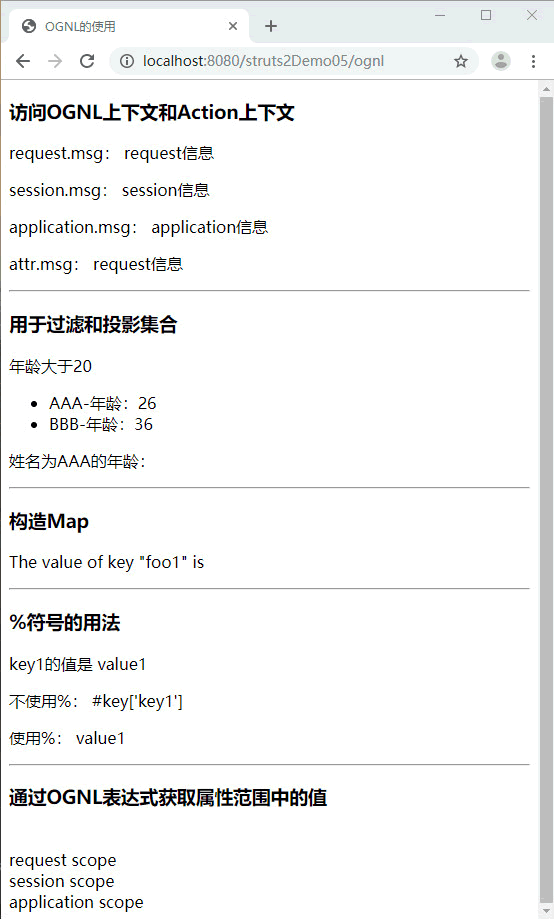OGNL表达式%、#和$用法详解(附带实例)
在实际开发过程中,OGNL 表达式要结合 struts2 的标签使用,主要就是%、#和$三个符号的使用。由于$被广泛应用于 EL 中,所以本小节将重点介绍%和#的用法。
1. # 符号
在 Struts2 框架中,#符号有三种用途,分别如下:
1)访问非根对象的属性。如访问 OGNL 上下文和 Action 上下文。由于 Struts2 中值栈被视为根对象,所以访问其他非根对象时,需要加#前缀。
#相当于 ActionContext.getContext()。例如‘#session.user’表达式相当于 ActionContext.getContext().getSession().getAttribute("user"),‘#request.userName’表达式相当于 request.getAttribute("userName")。
2)用于过滤和投影集合。如 books.{?#this.price>25}。
3)构造 Map。如 #{key1:value1,key2:value2},这种方式常用于给 radio 或 select、checkbox 等标签赋值。如果要在页面中取一个 Map 的值可以如下书写:<s:property value="#myMap['key']"/>。
2. % 符号
%是在标签的属性值被理解为字符串类型时,告诉执行环境‘%{}’中的是 OGNL 表达式,并计算 OGNL 表达式的值。
3. $ 符号
$符号主要用于在 Struts2 配置文件中引入 OGNL 表达式。例如下面的配置所示:
<action name="userAction_*" class="userAction" method="{1}">
<result name="add" type="redirect">
userAction_findById?userId=${User.userId}
</result>
</action>
为了让读者更好地理解和掌握 OGNL,下面通过一个案例演示 OGNL 的使用。
1. 创建项目
在 MyEclipse 中创建一个名称为 struts2Demo05 的 Web 项目,并引入 Struts2 所需 JAR 包,然后添加上过滤器信息。
2. 创建实体类
在项目的 src 目录下创建一个名称为 com.mengma.ognl 的包,在包中新建一个名称为 Person 的类,该类中包含 name、age 和 birthday 三个属性以及其 getter 和 setter 方法,如下所示。
package com.mengma.ognl;
import java.util.Date;
public class Person {
private String name;
private int age;
private Date birthday;
public String getName() {
return name;
}
public void setName(String name) {
this.name = name;
}
public int getAge() {
return age;
}
public void setAge(int age) {
this.age = age;
}
public Date getBirthday() {
return birthday;
}
public void setBirthday(Date birthday) {
this.birthday = birthday;
}
}
3. 创建 Action
在 com.mengma.ognl 包中创建一个名称为 OgnlAction 的 Action 类,编辑后如下所示。
package com.mengma.ognl;
import java.util.Date;
import java.util.LinkedList;
import java.util.List;
import javax.servlet.http.HttpServletRequest;
import org.apache.struts2.ServletActionContext;
import com.opensymphony.xwork2.ActionContext;
import com.opensymphony.xwork2.ActionSupport;
public class OgnlAction extends ActionSupport {
private List<Person> persons; // 声明Person对象
public List<Person> getPersons() {
return persons;
}
public void setPersons(List<Person> persons) {
this.persons = persons;
}
// 测试方法
public String ognlTest() throws Exception {
// 获得ActionContext实例
ActionContext ctx = ActionContext.getContext();
ctx.getApplication().put("msg", "application信息"); // 存入application中
ctx.getSession().put("msg", "session信息"); // 保存session
HttpServletRequest request = ServletActionContext.getRequest();
// 保存到request
request.setAttribute("msg", "request信息");
persons = new LinkedList<Person>();
Person person1 = new Person();
person1.setName("AAA");
person1.setAge(26);
person1.setBirthday(new Date());
persons.add(person1);
Person person2 = new Person();
person2.setName("BBB");
person2.setAge(36);
person2.setBirthday(new Date());
persons.add(person2);
Person person3 = new Person();
person3.setName("CCC");
person3.setAge(16);
person3.setBirthday(new Date());
persons.add(person3);
return SUCCESS;
}
}
上述代码中,首先声明了 Person 对象,并实现了它的 getter 和 setter 方法。然后在测试方法 ognlTest() 中,首先获得了 ActionContext 实例,然后通过 ActionContext 的实例分别向 Application、Session 和 Request 中存入相应信息,最后创建了 Person 对象,并向 Person 对象中添加了三个人员信息。
4. 创建配置文件
在项目的 src 目录下创建配置文件 struts.xml,并配置 Action 的信息。编辑后如下所示。
<?xml version="1.0" encoding="UTF-8"?>
<!DOCTYPE struts PUBLIC
"-//Apache Software Foundation//DTD Struts Configuration 2.3//EN"
"http://struts.apache.org/dtds/struts-2.3.dtd">
<struts>
<package name="struts2" namespace="/" extends="struts-default">
<action name="ognl" class="com.mengma.ognl.OgnlAction" method="ognlTest">
<result>/ognl.jsp</result>
</action>
</package>
</struts>
5. 创建显示页面文件
在项目的 WebContent 目录下创建一个名称为 ognl.jsp 的文件,编辑代码后如下所示。
<%@ page language="java" contentType="text/html; charset=UTF-8"
pageEncoding="UTF-8"%>
<%@taglib prefix="s" uri="/struts-tags"%>
<!DOCTYPE html PUBLIC "-//W3C//DTD HTML 4.01 Transitional//EN" "http://www.w3.org/TR/html4/loose.dtd">
<html>
<head>
<meta http-equiv="Content-Type" content="text/html; charset=UTF-8">
<title>OGNL的使用</title>
</head>
<body>
<h3>访问OGNL上下文和Action上下文</h3>
<!-- 使用OGNL访问属性值 -->
<p>
request.msg:
<s:property value="#request.msg" />
</p>
<p>
session.msg:
<s:property value="#session.msg" />
</p>
<p>
application.msg:
<s:property value="#application.msg" />
</p>
<p>
attr.msg:
<s:property value="#attr.msg" />
</p>
<hr />
<h3>用于过滤和投影集合</h3>
<p>年龄大于20</p>
<ul>
<!-- 判断年龄 -->
<s:iterator value="persons.{?#this.age>20}">
<li><s:property value="name" />-年龄:<s:property value="age" />
</li>
</s:iterator>
</ul>
<p>
姓名为AAA的年龄:
<s:property value="persons.{?#this.name=='AAA'}.{age}{0}" />
</p>
<hr />
<h3>构造Map</h3>
<s:set name="foobar" value="#{'foo1':'bar1','foo2':'bar2'}" />
<p>
The value of key "foo1" is
<s:property value="#foobar[foo1]" />
</p>
<hr />
<h3>%符号的用法</h3>
<s:set name="key" value="#{'key1':'value1','key2':'value2'}" />
<p>
key1的值是
<s:property value="#key['key1']" />
</p>
<p>
不使用%:
<s:url value="#key['key1']" />
</p>
<p>
使用%:
<s:url value="%{#key['key1']}" />
</p>
<hr />
<%
request.setAttribute("req", "request scope");
request.getSession().setAttribute("sess", "session scope");
request.getSession().getServletContext()
.setAttribute("app", "application scope");
%>
<h3>通过OGNL表达式获取属性范围中的值</h3>
<br />
<s:property value="#request.req" />
<br />
<s:property value="#session.sess" />
<br />
<s:property value="#application.app" />
<br />
</body>
</html>
6. 运行项目并查看结果
启动服务器后,在浏览器的地址栏中输入地址 http://localhost:8080/struts2Demo05/ognl,浏览器的显示结果如图 1 所示。




发表评论